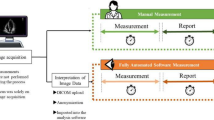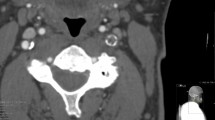Abstract
Purpose
The aim of this study is to evaluate the efficiency of applying a new non-rigid image registration method on two-dimensional echocardiographic images for computing the left ventricle (LV) myocardial motion field over a cardiac cycle.
Methods
The key feature of our method is to register all images in the sequence to a reference image (end-diastole image) using a hierarchical transformation model, which is a combination of an affine transformation for modeling the global LV motion and a free-form deformation (FFD) transformation based on B-splines for modeling the local LV deformation. Registration is done by minimizing a cost function associated with the image similarity based on a global pixel-based matching and the smoothness of transformation. The algorithm uses a fast and robust optimization strategy using a multiresolution approach for the estimation of parameters of the deformation model. The proposed algorithm is evaluated for calculating the displacement curves of two expert-identified anatomical landmarks in apical views of the LV for 10 healthy volunteers and 14 subjects with pathology. The proposed algorithm is also evaluated for classifying the regional LV wall motion abnormality using the calculation of the strain value at the end of systole in 288 segments as scored by two consensual experienced echocardiographers in a three-point scale: 1: normokinesia, 2: hypokinesia, and 3: akinesia. Moreover, we compared the results of the proposed registration algorithm to those previously obtained using the other image registration methods.
Results
Regarding to the reference two experienced echocardiographers, the results demonstrate the proposed algorithm more accurately estimates the displacement curve of the two anatomical landmarks in apical views than the other registration methods in all data set. Moreover, the p values of the t test for the strain value of each segment at the end of systole measured by the proposed algorithm show higher differences than the other registration method. These differences are between each pair of scores in all segments and in three segments of septum independently.
Conclusions
The clinical results show that the proposed algorithm can improve both the calculation of the displacement curve of every point of LV during a cardiac cycle and the classification of regional LV wall motion abnormality. Therefore, this diagnostic system can be used as a useful tool for clinical evaluation of the regional LV function.
Similar content being viewed by others
References
Lloyd-Jones D, Adams RJ, Brown TM et al (2010) Heart disease and stroke statistics-2010 update: a report from the American heart association. Circulation 121: 46–215
Gottdiener JS, Bednarz J, Devereux R et al (2004) Recommendations for use of echocardiography in clinical trials: a report from the american society of echocardiography’s guidelines and standards committee and the task force on echocardiography in clinical trials. J Am Soc Echocardiog 17: 1086–1119
Lang RM, Bierig M, Devereux RB et al (2006) Recommendations for chamber quantification. Eur J Echocardiogr 7: 79–108
Blondheim DS, Beeri R, Feinberg MS et al (2010) Reliability of visual assessment of global and segmental left ventricular function: a multicenter study by the Israeli Echocardiography Research Group. J Am Soc Echcardiogr 23: 258–264
Mor-Avi V, Vignon P, Koch R et al (1997) Segmental analysis of color kinesis images: new method for quantification of the magnitude and timing of endocardial motion during left ventricular systole and diastole. Circulation 95: 2082–2097
Vignon P, Mor-Avi V, Weinert L et al (1998) Quantitative evaluation of global and regional left ventricular diastolic function with color kinesis. Circulation 97: 1053–1061
Vermes E, Guyon P, Weingrod M et al (2000) Assessment of left ventricular regional wall motion by color kinesis technique: comparison with angiographic findings. Echocardiogr J Card 17: 521–527
Krahwinkel W, Haltern G, Gülker H (2000) Echocardiographic quantification of regional left ventricular wall motion with color kinesis. Am J Cardiol 85: 245–250
Sun JP, Super DM, Salvator A et al (2002) Quantification of regional left ventricular wall motion in newborns by color kinesis. J Am Soc Echocardiogr 15: 356–363
Sutherland GR, Stewart MJ, Groundstroem KW et al (1994) Color Doppler myocardial imaging: a new technique for the assessment of myocardial function. J Am Soc Echocardiogr 7: 441–458
Sutherland GR, Salvo GD, Claus P et al (2004) Strain and strain rate imaging: a new clinical approach to quantifying regional myocardial function. J Am Soc Echocardiogr 17: 788–802
Edvardsen T, Gerber BL, Garot J et al (2002) Quantitative assessment of intrinsic regional myocardial deformation by Doppler strain rate echocardiography in humans: validation against three dimensional tagged magnetic resonance imaging. Circulation 106: 50–56
Urheim S, Edvardsen T, Torp H et al (2000) Myocardial strain by Doppler echocardiography validation of a new method to quantify regional myocardial function. Circulation 102: 1158–1164
Edvardsen T, Skulstad H, Aakhus S et al (2001) Regional myocardial systolic function during acute myocardial ischemia assessed by strain Doppler echocardiography. J Am Coll Cardiol 37: 726–730
Stoylen A, Heimdal A, Bjornstad K et al (1999) Strain rate imaging by ultrasound in the diagnosis of regional dysfunction of the left ventricle. Echocardiogr J Card 16: 321–329
Jacob G, Noble JA, Behrenbruch C et al (2002) A shape-space-based approach to tracking myocardial borders and quantifying regional left-ventricular function applied in echocardiography. IEEE T Med Imaging 21: 226–238
Jacob G, Noble JA, Kelion AD et al (2001) Quantitative regional analysis of myocardial wall motion. Ultrasound Med Biol 27: 773–784
Bansod P, Desai UB, Merchant SN et al (2011) Segmentation of left ventricle in short-axis echocardiographic sequences by weighted radial edge filtering and adaptive recovery of dropout regions. Comput Methods Biomech Biomed Eng 14: 603–613
Qazi M, Fung G, Krishnan S (2007) Automated heart abnormality detection using sparse linear classifiers. IEEE Eng Med Biol Mag 26: 56–63
Bosch JG, Nijland F, Mitchell SC et al (2005) Computer-aided diagnosis via model-based shape analysis: automated classification of wall motion abnormalities in echocardiograms. Acad Radiol 12: 358–367
Leung KY, Bosch JG (2008) Segmental wall motion classification in echocardiograms using compact shape descriptors. Acad Radiol 15: 1416–1424
Marsousi M, Eftekhari A, Kocharian A, Alirezaie J (2010) Endocardial boundary extraction in left ventricular echocardiographic images using fast and adaptive B-spline snake algorithm. Int J Comp Assist Radiol Surg 5: 501–513
Cannesson M, Tanabe M, Suffoletto MS et al (2007) Novel two-dimensional echocardiographic image analysis system using artificial intelligence-learned pattern recognition for rapid automated ejection fraction. J Am Coll Cardiol 49: 217–226
Gifani P, Behnam H, Shalbaf A et al (2010) Automatic detection of end-diastole and end-systole from echocardiography images using manifold learning. Physiol Meas 31: 1091–1103
Korinek J, Wang J, Sengupta PP (2005) Two-dimensional strain: a Doppler independent ultrasound method for quantitation of regional deformation: validation in vitro and in vivo. J Am Soc Echocardiogr 18: 1247–1253
Amundsen BH, Helle-Valle T, Edvardsen T et al (2006) Noninvasive myocardial strain measurement by speckle tracking echocardiography: validation against sonomicrometry and tagged magnetic resonance imaging. J Am Coll Cardiol 47: 789– 793
Liel-Cohen N, Tsadok Y, Beeri R et al (2010) A new tool for automatic assessment of segmental wall motion based on longitudinal 2D strain: a multicenter study by the Israeli echocardiography research group. Circ Cardiovasc Imaging 3: 47–53
Perk G, Tunick PA, Kronzon I (2007) Non-Doppler two-dimensional strain imaging by echocardiography: from technical considerations to clinical applications. J Am Soc Echocardiogr 20: 234–243
Kukucka M, Nasseri B, Tscherkaschin A et al (2009) The feasibility of speckle tracking for intraoperative assessment of regional myocardial function by transesophageal echocardiography. J Cardiothor Vasc An 23: 462–467
Ledesma-Carbayo MJ, Mahía-Casado P, Santos A et al (2006) Cardiac motion analysis from ultrasound sequences using nonrigid registration: validation against Doppler tissue velocity. Ultrasound Med Biol 32: 483–490
Liu T, Zhou H, Pang Y, Lin F, Wu J (2005) Registration of ultrasonic cardiac images. Conf Proc IEEE Eng Med Biol Soc 6: 6583–6586
Klein S, Staring M, Pluim JPW (2007) Evaluation of optimization methods for nonrigid medical imaging registration using mutual information and B-splines. IEEE Trans Image Process 16: 2879–2890
Lee S, Wolberg G, Chwa KY et al (1996) Image metamorphosis with scattered feature constraints. IEEE Trans Visual Comput Graph 2: 337–354
Bardinet E, Cohen LD, Ayache N (1996) Tracking and motion analysis of the left ventricle with deformable superquadrics. Med Image Anal 1: 129–149
Wahba G (1990) Spline models for observational data. Soceity for Industrial and Applied Mathematics (SIAM), Philadelphia
Studholme C, Hill DLG, Hawkes DJ (1997) Automated 3D registration of MR and PET brain images by multi-resolution optimization of voxel similarity measures. Med Phys 24: 25–35
Kybic J, Unser M (2003) Fast parametric elastic image registration. IEEE Trans Image Process 12: 1427–1442
Abd-Elmoniem KZ, Stuber M, Prince JL (2008) Direct three-dimensional myocardial strain tensor quantification and tracking using zHARP. Med Image Anal 12: 778–786
Torp AH, Rabben SI, Stoylen A et al (2004) Detection and tracking of left ventricular landmarks in echocardiography. Proc IEEE Int Ultrason Symp 474–477
Willenheimer R, Cline C, Erhardt L (1997) Left ventricular atrioventricular plane displacement: an echocardiographic technique for rapid assessment of prognosis in heart failure. Heart 78: 230– 236
Eto Y, Yamada H, Shin JH et al (2005) Automated mitral annular tracking: a novel method for evaluating mitral annular motion using two dimensional echocardiography. J Am Soc Echocardiogr 18: 306–312
Nevo ST, van Stralen M, Vossepoel AM et al (2007) Automated tracking of the mitral valve annulus motion in apical echocardiographic images using multidimensional dynamic programming. Ultrasound Med Biol 33: 1389–1399
Reckefuss N, Butz T, Horstkotte D, Faber L (2011) Evaluation of longitudinal and radial left ventricular function by two-dimensional speckle-tracking echocardiography in a large cohort of normal probands. Int J Cardiovasc Imaging 27: 515–526
Author information
Authors and Affiliations
Corresponding author
Rights and permissions
About this article
Cite this article
Shalbaf, A., Behnam, H., Alizade-Sani, Z. et al. Left ventricle wall motion quantification from echocardiographic images by non-rigid image registration. Int J CARS 7, 769–783 (2012). https://doi.org/10.1007/s11548-012-0786-2
Received:
Accepted:
Published:
Issue Date:
DOI: https://doi.org/10.1007/s11548-012-0786-2




